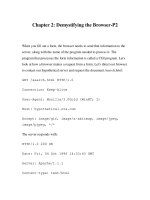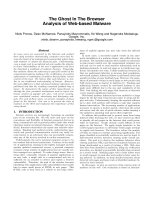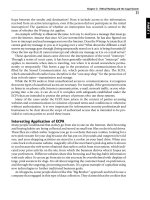The browser hackers handbook
Bạn đang xem bản rút gọn của tài liệu. Xem và tải ngay bản đầy đủ của tài liệu tại đây (29.99 MB, 650 trang )
www.it-ebooks.info
www.it-ebooks.info
The Browser Hacker’s
Handbook
Wade Alcorn
Christian Frichot
Michele Orrù
www.it-ebooks.info
The Browser Hacker’s Handbook
Published by
John Wiley & Sons, Inc.
10475 Crosspoint Boulevard
Indianapolis, IN 46256
www.wiley.com
Copyright © 2014 by John Wiley & Sons, Inc., Indianapolis, Indiana
Published simultaneously in Canada
ISBN: 978-1-118-66209-0
ISBN: 978-1-118-66210-6 (ebk)
ISBN: 978-1-118-91435-9 (ebk)
Manufactured in the United States of America
10 9 8 7 6 5 4 3 2 1
No part of this publication may be reproduced, stored in a retrieval system or transmitted in any form or
by any means, electronic, mechanical, photocopying, recording, scanning or otherwise, except as permitted
under Sections 107 or 108 of the 1976 United States Copyright Act, without either the prior written permission
of the Publisher, or authorization through payment of the appropriate per-copy fee to the Copyright Clearance
Center, 222 Rosewood Drive, Danvers, MA 01923, (978) 750-8400, fax (978) 646-8600. Requests to the Publisher
for permission should be addressed to the Permissions Department, John Wiley & Sons, Inc., 111 River Street,
Hoboken, NJ 07030, (201) 748-6011, fax (201) 748-6008, or online at />Limit of Liability/Disclaimer of Warranty: The publisher and the author make no representations or warranties with respect to the accuracy or completeness of the contents of this work and specifically disclaim all
warranties, including without limitation warranties of fitness for a particular purpose. No warranty may be
created or extended by sales or promotional materials. The advice and strategies contained herein may not
be suitable for every situation. This work is sold with the understanding that the publisher is not engaged in
rendering legal, accounting, or other professional services. If professional assistance is required, the services
of a competent professional person should be sought. Neither the publisher nor the author shall be liable for
damages arising herefrom. The fact that an organization or Web site is referred to in this work as a citation
and/or a potential source of further information does not mean that the author or the publisher endorses
the information the organization or website may provide or recommendations it may make. Further, readers
should be aware that Internet websites listed in this work may have changed or disappeared between when
this work was written and when it is read.
For general information on our other products and services please contact our Customer Care Department
within the United States at (877) 762-2974, outside the United States at (317) 572-3993 or fax (317) 572-4002.
Wiley publishes in a variety of print and electronic formats and by print-on-demand. Some material included
with standard print versions of this book may not be included in e-books or in print-on-demand. If this
book refers to media such as a CD or DVD that is not included in the version you purchased, you may
download this material at . For more information about Wiley products,
visit www.wiley.com.
Library of Congress Control Number: 2013958295
Trademarks: Wiley and the Wiley logo are trademarks or registered trademarks of John Wiley & Sons, Inc.
and/or its affiliates, in the United States and other countries, and may not be used without written permission.
All other trademarks are the property of their respective owners. John Wiley & Sons, Inc. is not associated
with any product or vendor mentioned in this book.
www.it-ebooks.info
About the Authors
Wade Alcorn (@WadeAlcorn) has been in the IT security game for longer than he
cares to remember. A childhood fascination with breaking stuff and solving puzzles
put him on the path to his career.
Wade is the creator of BeEF (The Browser Exploitation Framework), which is considered one of the most popular tools for exploiting browsers. Wade is also the General
Manager of the Asia Pacific arm of the NCC group, and has led security assessments
targeting critical infrastructure, banks, retailers, and other enterprises.
Wade is committed to the betterment of IT security, and enjoys contributing
to public groups and presenting at international conferences. He has published
leading technical papers on emerging threats and has discovered vulnerabilities
in widely used software.
Christian Frichot (@xntrik) has been into computers since the day his dad brought
home an Amiga 1000. Having discovered it couldn’t start Monkey Island with its
measly 512KB of RAM, he promptly complained until the impressive 2MB extension was acquired. Since then, Christian has worked in a number of different IT
industries, primarily Finance and Resources, until finally settling down to found
Asterisk Information Security in Perth, Australia.
Christian is also actively involved in developing software; with a particular focus
on data visualization, data analysis, and assisting businesses manage their security and processes more effectively. As one of the developers within the Browser
Exploitation Framework (BeEF), he also spends time researching how to best leverage browsers and their technology to assist in penetration testing.
While not busting browsers, Christian also engages with the security community
(have you seen how much he tweets?), not only as one of the Perth OWASP Chapter
Leads, but also as an active participant within the wider security community in Perth.
Michele Orrù (@antisnatchor) is the lead core developer and “smart-minds-recruiter”
for the BeEF project. He has a deep knowledge of programming in multiple languages and paradigms, and is excited to apply this knowledge while reading and
hacking code written by others.
iii
www.it-ebooks.info
iv
Michele loves lateral thinking, black metal, and the communist utopia (there is
still hope!). He also enjoys speaking and drinking at a multitude of hacking conferences, including CONFidence, DeepSec, Hacktivity, SecurityByte, AthCon, HackPra,
OWASP AppSec USA, 44Con, EUSecWest, Ruxcon, and more we just can’t disclose.
Besides having a grim passion for hacking and programming, he enjoys leaving
his Mac alone, while fishing on saltwater and “praying” for Kubrick’s resurrection.
About the Contributing Authors
Ryan Linn (@sussurro) is a penetration tester, an author, a developer, and an educator. He comes from a systems administration and Web application development
background, with many years of information technology (IT) security experience.
Ryan currently works as a full-time penetration tester and is a regular contributor
to open source projects including Metasploit, BeEF, and the Ettercap project. He has
spoken at numerous security conferences and events, including ISSA, DEF CON,
SecTor, and Black Hat. As the twelfth step of his WoW addiction recovery program,
he has gained numerous certifications, including the OSCE, GPEN, and GWAPT.
Martin Murfitt (@SystemSystemSyn) has a degree in physics but has worked as a
penetration tester of various forms for all of his professional career since graduating
in 2001 and stumbling randomly into the industry. Martin’s passion for computing
developed from a childhood of BBC micros in the 1980s. It isn’t over yet.
Martin is a consultant and manager for the EMEA division of the global Trustwave
SpiderLabs penetration testing team. SpiderLabs is the advanced security team at
Trustwave responsible for incident response, penetration testing, and application
security tests for Trustwave’s clients.
Martin has discovered publicly documented vulnerabilities on occasion, presented
sometimes or been working behind the scenes at conferences, such as Black Hat
USA and Shmoocon, but generally prefers to be found contemplating.
About the Technical Editor
Dr.-Ing. Mario Heiderich (@0x6D6172696F) is founder of the German pen-test outfit Cure53, which focuses on HTML5, SVG security, scriptless attacks and—most
importantly—browser security (or the abhorrent lack thereof). He also believes XSS
can be eradicated someday (actually quite soon) by using JavaScript. Mario invoked
the HTML5 security cheat sheet and several other security-related projects. In his
remaining time he delivers training and security consultancy for larger German and
international companies for sweet, sweet money and for the simple-minded fun in
breaking things. Mario has spoken at a large variety of international conferences—
both academic and industry-focused—co-authored two books and several academic
papers, and doesn’t see a problem in his two-year-old son having a tablet already.
www.it-ebooks.info
Credits
Executive Editor
Carol Long
Business Manager
Amy Knies
Project Editors
Ed Connor
Sydney Argenta Jones
Vice President and
Executive Group Publisher
Richard Swadley
Technical Editor
Mario Heiderich
Associate Publisher
Jim Minatel
Production Editor
Christine Mugnolo
Project Coordinator, Cover
Todd Klemme
Copy Editor
Kim Cofer
Compositor
Cody Gates,
Happenstance Type-O-Rama
Editorial Manager
Mary Beth Wakefield
Freelancer Editorial Manager
Rosemarie Graham
Associate Director of Marketing
David Mayhew
Marketing Manager
Ashley Zurcher
Proofreaders
Josh Chase and Sarah Kaikini,
Word One New York
Indexer
Johnna VanHoose Dinse
Cover Designer and Image
© Wiley
v
www.it-ebooks.info
www.it-ebooks.info
Acknowledgments
Nothing worthwhile in my life could be achieved without two very important
people. A huge thank you to my beautiful wife, Carla, for her inexhaustible
support and immeasurable inspiration. Though she is not mentioned on the
cover, her hand has been involved in refining every word of this book. I also
owe much to my hero and son, Owen. Without him continually showing that
every life challenge is best confronted with a grin firmly planted from ear to
ear, all obstacles would be so much greater.
I have also been lucky enough to work almost a decade with Rob Horton and
Sherief Hammad. They have always been a source of continual encouragement,
and have provided a supportive workplace that fostered creativity and lateral
thinking. And of course, thanks to Michele and Christian for taking this literary journey with me.
— Wade Alcorn
I first met her while breaking systems in a bank, and without her unending
patience I would not have been able to help write this book. To my wonderful
wife Tenille, I thank you with all my heart, and to our daughter growing inside
you—this book is for you (make sure you practice responsible hacking little
one). I must also thank the rest of my family, to my mother Julia and father
Maurice for providing me all the opportunities in life that have allowed me to
participate in this amazing information security industry. To my sisters Hélène,
Justine and Amy, you guys are inspiring, and your support has been very much
appreciated. To my Asterisk Info Sec family, for letting me complain about how
flipping hard this was, and for giving me the time to contribute to this book,
thank you so much David Taylor, Steve Schupp, Cole Bergersen, Greg Roberts
and Jarrod Burns. I must also thank all of the Australian and New Zealand
vii
www.it-ebooks.info
viiiAcknowledgments
hacker security crowd, all the friends that I’ve gotten to know over the Internet
and at conferences, I love being part of this community with you guys, keep on
rocking. And of course Wade and Michele, I have to thank you guys for inviting
me into this monumental task, for your patience, for everything you’ve taught
me, and for putting up with my crap!
— Christian Frichot
First of all I would like to thank my beloved Ewa for the moral support during the endless days and nights I’ve spent doing research and working on this
book. Great devotion goes to my parents who always supported me and gave me
the possibility to study and learn new things. Huge thanks to my good friends
Wade Alcorn and Mario Heiderich for research inspiration and mind-blowing
discussions. Without them this book wouldn’t have reached the quality we were
aiming for. Cheers to everyone who believed and still believes in Full Disclosure
as the way bugs should be disclosed. Finally, but not lastly, a big hug to all my
hacking friends and security researchers (you know who you are), who have
shared with me exploits and conference hangovers.
— Michele Orrù
This book is the result of a team effort. First and foremost, we would like to
acknowledge and thank our two contributing authors, Ryan Linn and Martin
Murfitt. We are also indebted to the wider security community, particularly the
cast of many who have contributed to BeEF over the years. Much of their effort
has provided the foundation for what is presented in this book today.
The good people at Wiley and the book’s Technical Editor are also due a very
large thank you. Mario Heiderich, Carol Long, and Ed Connor must have special
mention for their (unending) patience, support, and expertise.
Thanks to Krzysztof Kotowicz, Nick Freeman, Patroklos Argyroudis, and
Chariton Karamitas for their expert contributions. Though we can’t thank everyone
individually, there are some that we would like to give a special mention. They
are: Brendan Coles, Heather Pilkington, Giovanni Cattani, Tim Dillon, Bernardo
Damele, Bart Leppens, George Nicolau, Eldar Marcussen, Oliver Reeves, JeanLouis Huynen, Frederik Braun, David Taylor, Richard Brown, Roberto Suggi
Liverani, and Ty Miller. Undoubtedly we have missed important people. If we
have, the error is by omission, not intention.
— From all of us
www.it-ebooks.info
Contents
Introductionxv
Chapter 1
Web Browser Security
A Principal Principle
Exploring the Browser
1
2
3
Symbiosis with the Web Application
4
Same Origin Policy
4
HTTP Headers
5
Markup Languages
5
Cascading Style Sheets
6
Scripting6
Document Object Model
7
Rendering Engines
7
Geolocation9
Web Storage
9
Cross-origin Resource Sharing
9
HTML510
Vulnerabilities11
Evolutionary Pressures
12
HTTP Headers
13
Reflected XSS Filtering
15
Sandboxing15
Anti-phishing and Anti-malware
16
Mixed Content
17
Core Security Problems
17
Attack Surface
Surrendering Control
TCP Protocol Control
17
20
20
ix
www.it-ebooks.info
xContents
Encrypted Communication
20
Same Origin Policy
21
Fallacies21
Browser Hacking Methodology
22
Summary28
Questions28
Notes29
Chapter 2
Initiating Control
Understanding Control Initiation
Control Initiation Techniques
Using Cross-site Scripting Attacks
Using Compromised Web Applications
Using Advertising Networks
Using Social Engineering Attacks
Using Man-in-the-Middle Attacks
31
32
32
32
46
46
47
59
Summary72
Questions73
Notes73
Chapter 3
Retaining Control
Understanding Control Retention
Exploring Communication Techniques
77
78
79
Using XMLHttpRequest Polling
Using Cross-origin Resource Sharing
Using WebSocket Communication
Using Messaging Communication
Using DNS Tunnel Communication
80
83
84
86
89
Exploring Persistence Techniques
Using IFrames
Using Browser Events
Using Pop-Under Windows
Using Man-in-the-Browser Attacks
Evading Detection
96
96
98
101
104
110
Evasion using Encoding
Evasion using Obfuscation
111
116
Summary125
Questions126
Notes127
Chapter 4
Bypassing the Same Origin Policy
Understanding the Same Origin Policy
Understanding the SOP with the DOM
Understanding the SOP with CORS
Understanding the SOP with Plugins
Understanding the SOP with UI Redressing
Understanding the SOP with Browser History
www.it-ebooks.info
129
130
130
131
132
133
133
Contentsxi
Exploring SOP Bypasses
Bypassing SOP in Java
Bypassing SOP in Adobe Reader
Bypassing SOP in Adobe Flash
Bypassing SOP in Silverlight
Bypassing SOP in Internet Explorer
Bypassing SOP in Safari
Bypassing SOP in Firefox
Bypassing SOP in Opera
Bypassing SOP in Cloud Storage
Bypassing SOP in CORS
Exploiting SOP Bypasses
Proxying Requests
Exploiting UI Redressing Attacks
Exploiting Browser History
134
134
140
141
142
142
143
144
145
149
150
151
151
153
170
Summary178
Questions179
Notes179
Chapter 5
Attacking Users
Defacing Content
Capturing User Input
Using Focus Events
Using Keyboard Events
Using Mouse and Pointer Events
Using Form Events
Using IFrame Key Logging
Social Engineering
Using TabNabbing
Using the Fullscreen
Abusing UI Expectations
Using Signed Java Applets
Privacy Attacks
Non-cookie Session Tracking
Bypassing Anonymization
Attacking Password Managers
Controlling the Webcam and Microphone
183
183
187
188
190
192
195
196
197
198
199
204
223
228
230
231
234
236
Summary242
Questions243
Notes243
Chapter 6
Attacking Browsers
Fingerprinting Browsers
Fingerprinting using HTTP Headers
Fingerprinting using DOM Properties
Fingerprinting using Software Bugs
Fingerprinting using Quirks
www.it-ebooks.info
247
248
249
253
258
259
xiiContents
Bypassing Cookie Protections
Understanding the Structure
Understanding Attributes
Bypassing Path Attribute Restrictions
Overflowing the Cookie Jar
Using Cookies for Tracking
Sidejacking Attacks
Bypassing HTTPS
260
261
263
265
268
270
271
272
Downgrading HTTPS to HTTP
Attacking Certificates
Attacking the SSL/TLS Layer
Abusing Schemes
272
276
277
278
Abusing iOS
Abusing the Samsung Galaxy
Attacking JavaScript
Attacking Encryption in JavaScript
JavaScript and Heap Exploitation
Getting Shells using Metasploit
Getting Started with Metasploit
Choosing the Exploit
Executing a Single Exploit
Using Browser Autopwn
Using BeEF with Metasploit
279
281
283
283
286
293
294
295
296
300
302
Summary305
Questions305
Notes306
Chapter 7
Attacking Extensions
Understanding Extension Anatomy
How Extensions Differ from Plugins
How Extensions Differ from Add-ons
Exploring Privileges
Understanding Firefox Extensions
Understanding Chrome Extensions
Discussing Internet Explorer Extensions
Fingerprinting Extensions
Fingerprinting using HTTP Headers
Fingerprinting using the DOM
Fingerprinting using the Manifest
Attacking Extensions
Impersonating Extensions
Cross-context Scripting
Achieving OS Command Execution
Achieving OS Command Injection
311
312
312
313
313
314
321
330
331
331
332
335
336
336
339
355
359
Summary364
Questions365
Notes365
www.it-ebooks.info
Chapter 8
Contentsxiii
Attacking Plugins
Understanding Plugin Anatomy
How Plugins Differ from Extensions
How Plugins Differ from Standard Programs
Calling Plugins
How Plugins are Blocked
Fingerprinting Plugins
Detecting Plugins
Automatic Plugin Detection
Detecting Plugins in BeEF
Attacking Plugins
Bypassing Click to Play
Attacking Java
Attacking Flash
Attacking ActiveX Controls
Attacking PDF Readers
Attacking Media Plugins
371
372
372
374
374
376
377
377
379
380
382
382
388
400
403
408
410
Summary415
Questions416
Notes416
Chapter 9
Attacking Web Applications
Sending Cross-origin Requests
421
422
Enumerating Cross-origin Quirks
422
Preflight Requests
425
Implications425
Cross-origin Web Application Detection
426
Discovering Intranet Device IP Addresses
Enumerating Internal Domain Names
426
427
Cross-origin Web Application Fingerprinting
429
Requesting Known Resources
Cross-origin Authentication Detection
Exploiting Cross-site Request Forgery
Understanding Cross-site Request Forgery
Attacking Password Reset with XSRF
Using CSRF Tokens for Protection
Cross-origin Resource Detection
Cross-origin Web Application Vulnerability Detection
SQL Injection Vulnerabilities
Detecting Cross-site Scripting Vulnerabilities
430
436
440
440
443
444
445
450
450
465
Proxying through the Browser
469
Browsing through a Browser
Burp through a Browser
Sqlmap through a Browser
Browser through Flash
472
477
480
482
Launching Denial-of-Service Attacks
Web Application Pinch Points
DDoS Using Multiple Hooked Browsers
www.it-ebooks.info
487
487
489
xivContents
Launching Web Application Exploits
Cross-origin DNS Hijack
Cross-origin JBoss JMX Remote Command Execution
Cross-origin GlassFish Remote Command Execution
Cross-origin m0n0wall Remote Command Execution
Cross-origin Embedded Device Command Execution
493
493
495
497
501
502
Summary508
Questions508
Notes509
Chapter 10 Attacking Networks
Identifying Targets
Identifying the Hooked Browser’s Internal IP
Identifying the Hooked Browser’s Subnet
Ping Sweeping
513
514
514
520
523
Ping Sweeping using XMLHttpRequest
Ping Sweeping using Java
Port Scanning
523
528
531
Bypassing Port Banning
Port Scanning using the IMG Tag
Distributed Port Scanning
Fingerprinting Non-HTTP Services
Attacking Non-HTTP Services
NAT Pinning
Achieving Inter-protocol Communication
Achieving Inter-protocol Exploitation
Getting Shells using BeEF Bind
The BeEF Bind Shellcode
Using BeEF Bind in your Exploits
Using BeEF Bind as a Web Shell
532
537
539
542
545
545
549
564
579
579
585
596
Summary599
Questions600
Notes601
Chapter 11 Epilogue: Final Thoughts
605
Index609
www.it-ebooks.info
Introduction
Overview of This Book
You have chosen to read a book that will provide you with a practical understanding of hacking the everyday web browser and using it as a beachhead to
launch further attacks. The attacks will focus on the most popular browsers
and occasionally delve into the less mainstream ones. You will largely explore
Firefox, Chrome, and Internet Explorer. You will even dip your toes into the
water of modern mobile browsers and, although these won’t be the primary
focus, a lot of the attacks are relevant to them also.
Attackers and defenders both need to understand the dangers the web browser
has opened up for users. The reason is obvious. The web browser is possibly
the most important piece of software so far this century. It is humanity’s most
popular gateway to access the online environment—so much so that you have
watched it grow from cumbersome desktop software to a dominant application on
your phone, gaming console, and even your humble TV. It is today’s Swiss Army
knife of presenting, retrieving, and navigating data. Since Sir Tim Berners-Lee
invented his “little web browser that could” in 1990, this overachieving application has become one of the most recognizable pieces of software in the world.
Various estimates are being thrown about regarding the number of people
globally using web browsers. Doing some “back of the napkin” calculations
will reveal some extraordinary numbers. If you say that about one-third of the
global population is using the Internet, then you could estimate about 2.3 billion
browsers. Drawing further assumptions, you may discover that some are using
n+1 browsers. Some are using a browser at home, at work, and on their phones.
Even without Stephen Hawking’s mathematical insights, you have probably
arrived at a stupendous number.
xv
www.it-ebooks.info
xviIntroduction
Given this astonishing number of web browsers, it is not surprising that
with this popularity comes a plethora of security issues and opportunities for
exploitation. Written from the perspective of the hacker, this book will teach you
how to hack, and thereby how to defend, the modern browser in all its glory.
Who Should Read This Book
Do you have a technical background and an interest in understanding the practical risks of web browsers? If yes, then this book is for you. You may be looking
to defend your infrastructure or attack your client’s assets. You may have a role
as an administrator, developer, or even an information security professional.
Like a lot of us, you may simply have an overwhelming passion for security
and are continually looking to augment your knowledge.
This book has been written assuming you use a web browser regularly and
have had cause to look under the hood on occasion. It will be beneficial for you
to already have a grasp of fundamental security concepts or be happy to invest a
little time in some background research. The concept of the server-client model,
the HTTP protocol, and general security concepts should not be new to you.
Although it isn’t essential to have a programming background, it would be
useful to have some basic knowledge of the principles when reviewing the code
snippets. Numerous examples and demonstrations are provided throughout the
book to give you hands-on experience. These are written in various languages
with an emphasis on JavaScript, due to its dominance within browsers. As
unlikely as it may be, if you haven’t used JavaScript before, don’t be concerned.
The code also comes with explanations.
How This Book Is Organized
This book contains 10 chapters that are broadly categorized based on the attacking method. Where possible, sections are divided into vulnerability classes,
but this is not strictly the case. The book has been organized in a structure that
the authors envisage may be helpful to you as you embark upon a professional
security engagement.
During any security engagement, it is unlikely you’ll follow this book from
cover to cover. Rather, you will hop from one chapter to another, starting from
the introductory chapters and then branching into the most relevant chapter.
Alternatively, you may leap into a section where a concept is discussed in detail.
To support this more dynamic usage of the book, some concepts are replicated
to add context and coherence to the individual topics.
www.it-ebooks.info
Introductionxvii
Each chapter concludes with a set of questions for you to ponder. These questions will provide you with an opportunity to consolidate your understanding
of the core concepts of the chapter.
Chapter 1: Web Browser Security
This chapter starts you on your browser hacking journey. Your first step is to
explore important browser concepts and some of the core problems with browser
security. You explore the micro perimeter paradigm needed to defend organizations
today, and ponder some fallacies that continue to propagate insecure practices.
This chapter also examines a methodology specifying how attacks employing
the browser can be launched. It covers the attack surface presented by the browser
and how it increases the exposure of assets previously assumed protected.
Chapter 2: Initiating Control
Every single time a web browser connects to the web, it is asking for instructions. The browser then dutifully carries out the orders it has been provided by
the web server. Needless to say, boundaries do exist, but the browser provides
a powerful environment for attackers to employ.
This chapter walks you through the first phase of browser attacks by exploring
how to execute your code within the target browser. You sample the delights
of Cross-site Scripting vulnerabilities, Man-in-the-Middle attacks, social engineering, and more.
Chapter 3: Retaining Control
The initiation techniques discussed up to this point only allow you to execute
your instructions once. This chapter introduces how to maintain communication and persistence, giving you interactive control with the ability to execute
multiple rounds of commands.
In a typical hacking session, you will want to maintain a communication channel with the browser and, where possible, persist your control across restarts.
Without this, you will quickly find yourself back at square one trying to entice
your target to connect over and over again.
In this chapter, you learn how to use a payload to maintain communication
with the browser, enabling you to send multiple iterations of instructions. This
will ensure that you don’t waste any opportunities once you have received that
all-important initial connection. Armed with this knowledge, you are now ready
to launch the various attacks presented in the following chapters.
www.it-ebooks.info
xviiiIntroduction
Chapter 4: Bypassing the Same Origin Policy
In very basic terms, the Same Origin Policy (SOP) restricts one website from
interacting with another one. It is possibly the most fundamental concept in web
browser security. You would, therefore, expect that it would be consistent across
browser components and trivial to predict the impacts of common actions. This
chapter shows you that this is not the case.
Web developers are poked with an SOP stick at almost every turn; there is
variance between how SOP is applied to the browser itself, extensions, and
even plugins. This lack of consistency and understanding provides attackers
opportunities to exploit edge cases.
This chapter explores bypassing the different SOP controls in the browser. You
even discover issues with drag-and-drop and various UI redressing and timing
attacks. One of the more surprising things you learn in this chapter is that with
the right coding, SOP bypasses can transform the browser into an HTTP proxy.
Chapter 5: Attacking Users
Humans are often referred to as the weakest link in security. This chapter focuses
on attacks targeting the unsuspecting user’s wetware. Some of the attacks further leverage social engineering tactics discussed in Chapter 2. Other attacks
exploit features of browsers, and their trust in received code.
In this chapter, you explore de-anonymization and covertly enabling the web
camera, as well as running malicious executables with and without any explicit
user intervention.
Chapter 6: Attacking Browsers
While this entire book is about attacking the browser and circumventing its
security controls, this chapter focuses on what could be referred to as the barebones browser. That is, the browser without the extensions and plugins.
In this chapter, you explore the process of directly attacking the browser.
You delve into fingerprinting the browser to distinguish between vendors and
versions. You also learn how to launch attacks and compromise the machine
running the browser.
Chapter 7: Attacking Extensions
This chapter focuses on exploiting vulnerabilities in browser extensions. An extension is software that adds (or removes) functionality to (or from) the web browser.
An extension is not a standalone program unlike their second cousins, plugins. You
might be familiar with extensions like LastPass, Firebug, AdBlock, and NoScript.
www.it-ebooks.info
Introductionxix
Extensions execute code in trusted zones with increased privileges and take
input from less trusted zones like the Internet. This will ring alarm bells for
seasoned security professionals. There is a real risk of injection attacks, and in
practice, some of these attacks lead to remote code execution.
In this chapter, you explore the anatomy of extension attacks. You delve into
privilege escalation exploits that will give you access to the privileged browser
(or chrome://) zone and result in command execution.
Chapter 8: Attacking Plugins
This chapter focuses on attacking web browser plugins, which are pieces of
software that add specific functionality to web browsers. In most instances,
plugin software can run independently without the web browser.
Popular plugins include Acrobat Reader, Flash Player, Java, QuickTime,
RealPlayer, Shockwave, and Windows Media Player. Some of these are necessary for your browsing experience, and some for your business functions. Flash
is needed for sites like YouTube (which is potentially moving to HTML5) and
Java is required for business functions such as WebEx.
Plugins have been plagued with vulnerabilities and continue to be a rich
source of exploits. As you’ll discover, plugin vulnerabilities remain one of the
most reliable avenues to take control of a browser.
In this chapter, you explore analyzing and exploiting browser plugins using
popular, freely available tools. You learn about bypassing protection mechanisms like Click to Play and taking control of the target through vulnerabilities
in the plugins.
Chapter 9: Attacking Web Applications
Your everyday web browser can conduct powerful web-based attacks while
still abiding by accepted security controls. Web browsers are designed to communicate to web servers using HTTP. These HTTP functions can be turned
against themselves to achieve a compromise of a target that is not even on the
current origin.
This chapter focuses on attacks that can be launched from the browser without
violating the SOP. You learn various tricks that allow cross-origin fingerprinting
of resources and even cross-origin identification of common web application
vulnerabilities. You may be surprised to learn that when using the browser, it
is possible to discover and exploit cross-origin Cross-site Scripting and SQL
injection vulnerabilities, too.
By chapter’s end, you’ll understand how to achieve cross-origin remote code
execution. You will also discover Cross-site Request Forgery attacks, time-based
delay enumeration, attacking authentication, and Denial-of-Service attacks.
www.it-ebooks.info
xxIntroduction
Chapter 10: Attacking Networks
This final attacking chapter covers identifying the intranet’s attack surface by port
scanning to discover previously unknown hosts. The exploration continues by
presenting techniques such as NAT Pinning.
In this chapter, you also discover attacks that use the web browser to communicate directly to non-web services. You learn how to harness the power of the Interprotocol Exploitation technique to compromise targets on the browser’s intranet.
Epilogue: Final Thoughts
By this stage in the book you will have learned numerous offensive techniques
and the chapters should now serve as a reference to quickly re-ramp up your
knowledge. We leave you with some thoughts to ponder, particularly around
the future of browser security.
What’s on the Web
The website that accompanies this book is located at https://browserhacker
.com or the Wiley website at: www.wiley.com/go/browserhackershandbook. On
this site you will find information that augments the contents of this book. It is
not a substitute, but the details will complement the knowledge you get from
within the chapters.
The website also includes code snippets for you to copy and paste. This will
save you from having to transcribe them manually and has the added benefit of
(hopefully) delaying the onset of RSI! You’ll also find demonstration videos to
view and answers to each chapter’s questions for you to check your knowledge.
Our modesty requires us to admit that there will inevitably be mistakes
in this book. It is an unfortunate truth that all but one of the authors of this
book is fallible (we are still in violent disagreement about which one of us is
the infallible one). Please check to find out if we
have determined the fallible one and, of course, for the corrections to mistakes
discovered by our readers. If you find an error, please check the site and, if it
isn’t listed, kindly notify us.
Compiling Your Arsenal
This book covers various tools you can employ to hack web browsers and it is
valuable to have a variety in your toolkit.
An important point to stress is that this book aims to give you knowledge of
how the tools work from a low level. This will be an extremely valuable insight
www.it-ebooks.info
Introductionxxi
as your skill level increases. The aim is not only to teach you how to use tools,
but to understand them and enable you to spot the inevitable false positives.
It is hoped that you will take an understanding that all tools have weaknesses and
that you should combine your knowledge with this fact in your security engagements. The most important tool in your toolkit is your knowledge. The authors’
primary aim is to expand your understanding and not your software library.
A couple of the tools you will see frequently throughout this book are the
Browser Exploitation Framework (BeEF) and Metasploit. Of course, many others
are covered and you will become familiar with all their strengths and weaknesses.
The authors are core developers on the BeEF project and steered the development of this community tool to match the methodology described herein.
Numerous examples have come from the BeEF codebase where the majority of
the processes have been automated.
Authorization Denied
This is a good point to pause in the book and highlight the professionalism
needed within the security disciplines. In no way should anything in this book be
interpreted as providing permission or encouragement to conduct an illegal act.
Ensure that you have received full permission prior to conducting a hacking
engagement. This is true of most of the security disciplines and is applicable
for all the techniques discussed in this book.
Good to Go!
Web browser security is one of the fastest moving arms races on the Internet.
This makes it a fascinating and fun area for anyone interested in security to
get involved. The pace is not slowing because businesses continually push the
boundaries of what browsers can do.
We have seen large and small companies alike aggressively changing the
assumption that usable and responsive software runs solely on the desktop
computer. Anyone predicting a decline in browser popularity should doublecheck their Ouija board because they probably still have that buggy Java plugin
enabled!
Combine the arms race and business interests with the continually changing
web browser attack surface, and the security challenges won’t stop coming. So,
let’s jump right in and start hacking browsers!
www.it-ebooks.info
www.it-ebooks.info
CHAPTER
1
Web Browser Security
A lot of responsibility is placed upon the broad shoulders of the humble web
browser. The web browser is designed to request instructions from all over the
Internet, and these instructions are then executed almost without question. The
browser must faithfully assemble the remotely retrieved content into a standardized digestible form and support the rich feature set available in today’s Web 2.0.
Remember, this is the same software with which you conduct your important
affairs—from maintaining your social networks to online banking. This software
is also expected to protect you even if you venture down the many figurative dark
alleys of the Internet. It is expected to support venturing down such an alleyway
while making a simultaneous secure purchase in another tab or window. Many
assume their browser to be like an armored car, providing a secure and comfortable environment to observe the outside world, protecting all aspects of one’s
personal interests and deflecting anything dangerous. By the end of this book,
you will have the information to decide if this is a sound assumption.
The development team of this “all singing and all dancing” software has to
ensure that each of its numerous nooks and crannies don’t provide an avenue for
a hacker. Whether or not you consciously know it, every time you use a browser,
you are trusting a team of people you have probably never met (and likely never
will) to protect your important information from the attackers on the Internet.
This chapter introduces a methodology for web browser hacking that can
be employed for offensive engagements. You explore the web browser’s role
1
www.it-ebooks.info









